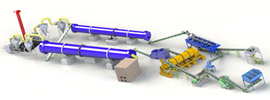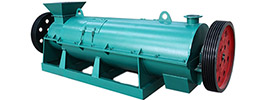The fermentation of organic fertilizer is a biodegradation process closely related to temperature, with temperature changes directly affecting fermentation efficiency and product quality. Below is a detailed explanation from the perspectives of fermentation stages, temperature control points, regulation methods, and environmental adaptability:
I. Fermentation Stages and Temperature Changes
Organic fertilizer fermentation typically progresses through four stages, each characterized by distinct temperature profiles and microbial activities:
- Heating Phase (Initial Stage)
- Temperature Change: Gradual rise from ambient temperature to 40-45°C.
- Microbial Activity: Mesophilic microorganisms (e.g., bacteria, fungi, actinomycetes) dominate, decomposing simple organic matter like sugars and starches while releasing heat.
- Key Point: Maintain a loose pile structure to promote oxygen circulation and prevent local anaerobic conditions.
- Thermophilic Phase (Core Stage)
- Temperature Change: Elevation to 50-70°C, with an optimal range of 55-60°C.
- Microbial Activity: Thermophilic microorganisms (e.g., Bacillus spp., actinomycetes) become predominant, breaking down complex organic matter such as cellulose and lignin.
- Key Points:
- Sustain temperatures above 50°C for at least 5 days to eliminate pathogens, insect eggs, and weed seeds (sanitization).
- If temperatures exceed 70°C, microbial activity declines; prompt pile turning is necessary to cool.
- Cooling Phase (Transitional Stage)
- Temperature Change: Gradual reduction to below 50°C.
- Microbial Activity: Mesophilic microorganisms resume activity, decomposing residual refractory organic matter (e.g., hemicellulose, proteins).
- Key Point: Humus content begins to stabilize, with reduced oxygen demand.
- Maturation Phase (Completion Stage)
- Temperature Change: Stabilization at ambient temperature, signaling fermentation completion.
- Material Characteristics: Dark brown to black, odorless, with humus content exceeding 30% and a stable pH of 6.5-8.5.
II. Temperature Control Points
- Optimal Temperature Range
- Thermophilic Phase: 55-60°C (maximizes microbial activity and sanitization efficacy).
- Minimum Requirement: If only maturation (not sanitization) is desired, temperatures above 15°C suffice, though fermentation slows.
- Impact of Temperature Anomalies
- Excessive Heat (>70°C): Causes carbonization of organic matter, nutrient loss, and microbial death.
- Insufficient Heat (<15°C): Slows or halts fermentation; insulation measures (e.g., indoor fermentation) may be required.
III. Temperature Regulation Methods
- Pile Turning and Aeration
- Thermophilic Phase: Turn the pile to replenish oxygen if temperatures drop below 50°C; turn immediately if exceeding 65°C.
- Cooling Phase: Reduce turning frequency to prevent excessive heat loss.
- Temperature Monitoring
- Tools: Use a thermometer with a probe length ≥30 cm, inserted ≥30 cm into the pile core.
- Frequency: Monitor 1-2 times daily during the thermophilic phase; every 2-3 days otherwise.
IV. Environmental Adaptability
- Seasonal and Regional Considerations
- Southern Regions: Higher ambient temperatures facilitate fermentation.
- Northern Cold Regions: Insulation measures (e.g., indoor fermentation, covering) are essential in winter.
- Feedstock Ratio Adjustment
- Carbon-to-Nitrogen Ratio (C/N): Optimize to 25-30:1 by adding straw or mushroom residue.
- Moisture Content: Maintain at 50-60% to prevent anaerobic conditions or microbial inhibition.
V. Summary
Effective temperature management in organic fertilizer fermentation balances efficiency and quality:
- The thermophilic phase is critical for sanitization and complex organic matter decomposition, requiring strict control at 55-60°C.
- Pile turning and aeration are core regulatory tools, adjusted flexibly based on temperature fluctuations.
- Environmental adaptability necessitates tailored insulation or cooling measures depending on regional climates.
By scientifically controlling temperature, efficient, safe, and high-quality organic fertilizer with optimal maturation and nutrient stability can be produced.
 Send us a Email
Send us a Email Wulong Industrial Cluster
Wulong Industrial Cluster Have any question?
Have any question?



















